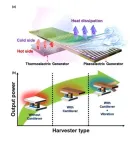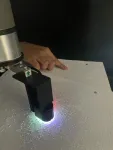(Press-News.org)
Cancer Research UK-funded scientists have made an unusual discovery that could help to identify patients who are up to two and a half times more likely to respond to currently available cancer drugs.
Scientists at the Cancer Research UK Scotland Institute and Memorial Sloan Kettering Cancer Centre in the USA have “rewired” the DNA of mitochondria – energy factories found in every living cell. They found that creating mutations in parts of this DNA determines how well cancer will respond to immunotherapy – treatments which harness the body’s natural defences to attack cancer cells.
This discovery opens up new ways to identify patients who could benefit most from immunotherapy by testing for mitochondrial DNA mutations. Half of all cancers have mitochondrial DNA (mtDNA) mutations and this discovery shows for the first time that they could be exploited to improve cancer treatment.
In the future, combining treatments that mimic the effect of these mutations with immunotherapy could increase the chances of successful treatment for multiple types of cancer.
In a paper published in the journal Nature Cancer today (Monday 29th January), the scientists demonstrate for the first time a direct link between mitochondrial DNA (mtDNA) mutations and response to cancer treatment. Surprisingly, they found that tumours with high levels of mtDNA mutations are up to two and a half times more likely to respond to treatment with an immunotherapy drug called nivolumab.
Nivolumab works by releasing a “brake” on the immune system to attack cancer cells. It is currently used to treat several different cancers, including melanoma, lung cancer, liver cancer and bowel cancer. The scientists believe that they could routinely test for mitochondrial DNA mutations in the future – enabling doctors to figure out which patients will benefit most from immunotherapy before starting treatment.
They also believe that mimicking the effects of the mitochondrial DNA mutations could make treatment-resistant cancers sensitive to immunotherapy – enabling thousands more cancer patients to benefit from this pioneering treatment.
The technology behind the discovery is now the subject of patents filed by Cancer Research Horizons, Cancer Research UK’s innovation arm. It will help bring the technology to market to allow new treatments to be developed which disrupt the energy sources cancer uses to spread and grow. To date, Cancer Research Horizons has brought 11 new cancer drugs to market, which have been used in over six million courses of cancer treatment worldwide.
Group Leader at the Cancer Research UK Scotland Institute and the University of Glasgow and co-lead author of the study, Dr Payam Gammage, said:
“Cancer is a disease of our own bodies. Because cancer cells can look similar to healthy cells on the outside, getting our immune systems to recognise and destroy cancer cells is a complicated task.
“More than half of cancers have mutations in their mitochondrial DNA. But when we engineered these mutations in the lab, we found that tumours which have the most mutated mitochondrial DNA are far more sensitive to immunotherapy.
“Thanks to this research, we now have a powerful tool which gives us an entirely new approach to stopping cancer in its tracks.”
Assistant Attending Computational Oncologist at Memorial Sloan Kettering Cancer Center and co-lead author of the study, Dr Ed Reznik, said:
“Mitochondrial DNA has been an enigma for decades. Every cell has thousands of copies and until now it’s been very challenging to engineer mutations consistently to study how mtDNA mutations affect cancer.
“For the first time, we can see exactly what mitochondrial DNA mutations do when we create them in the lab. But what took us by surprise is how much the cells around the tumour are affected – which we can exploit to make the tumour vulnerable to treatment.
“This research opens up an entire world where we can rewire the energy sources of tumours – and potentially short-circuit them to beat cancer sooner.”
Executive Director of Research and Innovation at Cancer Research UK and CEO of Cancer Research Horizons, Dr Iain Foulkes, said:
“After years of painstaking lab research funded by Cancer Research UK, we have identified a vital weak spot in cancer. Mitochondrial DNA mutations are a common part of cancer and this amazing discovery has limitless potential.
“Treatments which exploit over-burdened mitochondria in cancer are now possible. Now we need clinical trials to see which combinations work best in patients. Through our innovation engine Cancer Research Horizons, we’re planning to accelerate this discovery into the clinic and ensure as many patients as possible can benefit.”
The paper, titled “Mitochondrial DNA mutations drive aerobic glycolysis to enhance checkpoint blockade in melanoma” was published today (Monday 29th January) in Nature Cancer*.
END
For decades scientists have been trying to solve Feynman’s Sprinkler Problem: How does a sprinkler running in reverse—in which the water flows into the device rather than out of it—work? Through a series of experiments, a team of mathematicians has figured out how flowing fluids exert forces and move structures, thereby revealing the answer to this long-standing mystery.
“Our study solves the problem by combining precision lab experiments with mathematical modeling that explains how a reverse sprinkler operates,” explains Leif Ristroph, an associate professor at New York University’s Courant Institute of Mathematical Sciences and the senior author ...
(Utrecht/Vienna, 29.1.2024) Neuroblastoma mainly affects toddlers and young children - in the EU region there are 1500 new cases per year. Neuroblastoma is a malignant tumor of the peripheral nervous system and around 50% of patients are high-risk cases. Recurrences occur frequently, and conventional therapies are no longer effective for these children. With liquid biopsies it is possible to monitor therapy success and to predict the recurrence of the tumor in time to take medical countermeasures. Scientists from leading European ...
Social robots can help us with many things: teaching, learning, caring. Because they’re designed to interact with humans, they’re designed to make us comfortable — and that includes the way they talk. But how should they talk? Some research suggests that people like robots to use a familiar accent or dialect, while other research suggests the opposite.
“Surprisingly, people have mixed feelings about robots speaking in a dialect — some like it, while others prefer standard language,” said Katharina Kühne of the University of Potsdam, lead author ...
Harvesting energy sources such as heat, vibration, light, and electromagnetic waves from everyday environments such as industrial sites and automobiles and converting them into electrical energy is known as energy harvesting. Energy harvesting makes it easier to power today's popular IoT sensors and wireless devices that are located in environments where battery replacement is difficult.
Dr. Hyun-Cheol Song and Dr. Sunghoon Hur of Electronic Materials Research Center at the Korea Institute of Science and Technology (KIST) have developed a hybrid energy harvesting ...
Organ donation after medical assistance in dying (MAiD) represented 14% of Quebec's total deceased donations in 2022, according to a new study in CMAJ (Canadian Medical Association Journal) https://www.cmaj.ca/lookup/doi/10.1503/cmaj.230883.
To understand the impact of organ donation after MAiD, Quebec researchers analyzed data on all patients referred to Transplant Québec for possible organ donation after MAiD from January 2018 to December 2022. This represented the first 5 full years when organ donation after MAiD was allowed in the province. Over the 5-year period, Transplant Québec received 245 referrals for donation after MAiD, ...
A new review in CMAJ (Canadian Medical Association Journal) is aimed at helping clinicians diagnose and manage polycystic ovarian syndrome (PCOS), an endocrine disorder that affects about 10% of femaleshttps://www.cmaj.ca/lookup/doi/10.1503/cmaj.231251.
This disorder affects females of reproductive age and is associated with infertility, miscarriage and pregnancy complications. Its long-term health consequences include hypertension, cancer risks, and metabolic and psychological impacts. Patients usually present to health care between ages 18 and 39 years complaining of menstrual cycle irregularities, ...
Researchers have developed a robotic sensor that incorporates artificial intelligence techniques to read braille at speeds roughly double that of most human readers.
The research team, from the University of Cambridge, used machine learning algorithms to teach a robotic sensor to quickly slide over lines of braille text. The robot was able to read the braille at 315 words per minute at close to 90% accuracy.
Although the robot braille reader was not developed as an assistive technology, the researchers say the high sensitivity required to read braille makes it an ideal test in the development of robot ...
Overweight and obesity are contributing to rising death rates from bowel cancer among people aged 25-49 years in the European Union (EU) and the UK, although death rates from this type of cancer are decreasing overall across Europe.
These findings are from a new study published in the leading cancer journal Annals of Oncology [1] today (Monday), which predicts death rates from cancer in the EU and UK for 2024. It is the first time that an increase in bowel cancer death rates among young adults has been predicted for the EU, and it confirms a trend in the UK that the researchers first noted in 2021.
Researchers led by Carlo La Vecchia (MD), ...
Engaging in music throughout your life is associated with better brain health in older age, according to a new study published by experts at the University of Exeter.
Scientists working on PROTECT, an online study open to people aged 40 and over, reviewed data from more than a thousand adults over the age of 40 to see the effect of playing a musical instrument – or singing in a choir - on brain health. Over 25000 people have signed up for the PROTECT study, which has been running for 10 years.
The team reviewed participants’ musical experience and lifetime exposure ...
A study of pediatric heart surgery centers across the United States has demonstrated that, when it comes to successful surgery, it’s not just the size of the program that matters in determining quality outcomes.
Historically, hospitals with a “low volume” of pediatric heart operations—in this case, those that perform 103 surgeries or fewer a year—have been associated with worse outcomes for patients. However, a team led by D. Chauhan, MD, from WVU Medicine Children’s ...



